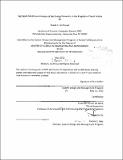| dc.contributor.advisor | Olivier de Weck. | en_US |
| dc.contributor.author | Al-Ahmed, Khalid A. (Khalid Abdulrahim) | en_US |
| dc.contributor.other | Massachusetts Institute of Technology. Engineering Systems Division. | en_US |
| dc.coverage.spatial | a-su--- | en_US |
| dc.date.accessioned | 2013-07-10T14:50:29Z | |
| dc.date.available | 2013-07-10T14:50:29Z | |
| dc.date.issued | 2012 | en_US |
| dc.identifier.uri | http://hdl.handle.net/1721.1/79508 | |
| dc.description | Thesis (S.M.)--Massachusetts Institute of Technology, Engineering Systems Division, 2012. | en_US |
| dc.description | "May 2012." Cataloged from PDF version of thesis. | en_US |
| dc.description | Includes bibliographical references (p. 135-140). | en_US |
| dc.description.abstract | The Kingdom of Saudi Arabia is facing a crisis in the near future centered on increasing energy consumption. Today, the kingdom consumes approximately 1/3 of its oil production. If no action is taken and the kingdom continues business as usual, by 2026 it will consume 50% of its production, and by 2047 its entire production. A large percentage of oil produced in the kingdom is used for electrical generation and to fulfill increasing industrial, transportation, and water demand. In 2010 the kingdom consumed 212,262.6 GWh-9.7% more electricity than in the previous year. This thesis analyzes how the current situation has developed, then lays out the important elements of Saudi energy dynamics on a national scale. The following chapters demonstrate the application of causal loop analysis to the Saudi situation through a system dynamics model. Technical, financial, and socio-economic challenges in energy management were used to derive key dynamic variables included in the model which shows how increasing GDP and population drive local electrical demand. Energy policy scenarios involving increased use of natural gas and/or diversification into solar electrical generation were simulated by the model. The model showed that the result would be increased oil exports, which in return yielded a higher GDP and more investments in economic and industrial growth. The output of the model showed that diversification would defer the crisis for only a few years if current consumption trends continue. A hybrid scenario that couples diversification with an aggressive energy efficiency policy to stimulate reduced consumption demonstrated electrical consumption levels below 400,000 GWh, sustainable over the next 35 years. In all other scenarios electrical consumption increased rapidly beyond 600,000 GWh over the same period. The thesis concludes with some key findings and recommendations for the future development of sustainable energy policies in the kingdom and the region. | en_US |
| dc.description.statementofresponsibility | by Khalid A. Al-Ahmed. | en_US |
| dc.format.extent | 140 p. | en_US |
| dc.language.iso | eng | en_US |
| dc.publisher | Massachusetts Institute of Technology | en_US |
| dc.rights | M.I.T. theses are protected by
copyright. They may be viewed from this source for any purpose, but
reproduction or distribution in any format is prohibited without written
permission. See provided URL for inquiries about permission. | en_US |
| dc.rights.uri | http://dspace.mit.edu/handle/1721.1/7582 | en_US |
| dc.subject | Engineering Systems Division. | en_US |
| dc.title | Aggregate model and analysis of the energy dynamics in the Kingdom of Saudi Arabia | en_US |
| dc.type | Thesis | en_US |
| dc.description.degree | S.M. | en_US |
| dc.contributor.department | Massachusetts Institute of Technology. Engineering Systems Division | |
| dc.identifier.oclc | 849743745 | en_US |
